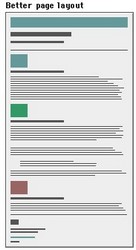document structure and presentation skills
How to present documents effectively
When you have finished writing and editing an important document, you need to present it in the best possible way. You should create what are called the front and back materials.
The front and back materials comprise any or all of the following parts.
Front materials 
- Title page
- Preface
- Contents page
- Executive summary
- Introduction
Back materials
- Notes
- Bibliography
- Glossary
- Appendices
Front material
The title page
The title page should contain:
- The title of the document
- The date
- The writer’s name
- The recipient’s name
Example
Proposal
Installing new records system
for
Bindweed Mowers Ltd
Written by John Atherton
10 September 2010
For the attention of Jane Brown
Preface
A preface is a short preliminary text which puts the main document into a specific context. Its purpose is to prepare the reader for the main content of the report or proposal that follows.It is a form of ‘introduction’ to the main document. A preface may not always be necessary – but here’s an example:
Preface
This report is based on the research carried out by Myers and Carrston in 1991. Their findings were so revolutionary in the field of preventative medicine that we could not ignore the need to consider genetic modification as a way forward.
We trust that the reader will understand that since the start of the research project, there have been significant shifts resulting from both political and scientific pressures in this field of scientific development.
Contents page
The function of the contents page is to provide an easy way of locating the sections, chapters and any other parts of the document.
The titles of the various sections and chapters should be listed accurately and consistently along with the relevant page numbers.
The titles should appear on the left of the page and the numbers on the right.
Contents
Introduction
Section I
Ledwards and Smith
Recent decline of the industry
The recovery period
Section 2
Questions for the Ministry
Death of sixteen patients
Executive summary
An executive summary is sometimes included at the beginning of a long report or proposal. It gives an overview of the main points contained in the longer document.
For instance in a report, the findings might be summarised along with some recommendations for further action.
In a proposal, the idea, along with items such as the costings or the main problems might be summarised.
The audience for an executive summary is people who needs to be aware in outline of what is going on. These people do not need to know the detail, and so can assimilate the main points or issues without needing to read the whole of a long document.
Introduction
An introduction should provide a context for rest of the document. It should set the scene for what is to follow.
It might provide an explanation of why the document has been written; the topics which will be under consideration, and its overall purpose.
Back material
Glossary
A glossary is needed in a document which uses a lot of technical issues. Words which are specialist or technical jargon are listed, usually in alphabetical order, each with a brief definition.
The glossary can also be used to explain acronyms used in the place of companies or organisations – such a NWBF = National Wholesale Bakers Federation.
Appendix
An appendix contains material which supports or expands on material in the body of a report.
- survey materials such as questionnaires
- raw data gathered in the study
- regulations or statutes
- illustrations, maps, or diagrams
Bibliography
A bibliography lists the publication details of any work referred to during the preparation of the report, such as books or periodicals.
Each bibliographic entry contains the following information – in this sequence
Bibliography – books
- name of author(s), surname
- full title of book (in italics)
- series (if any)
- volume number (if applicable)
- edition (if not the first)
- city of publication
- publishers name
- publication date
Jones, Seymour, and M.Bruce Cohen, The Emerging Business: Managing for Growth, New York: John Wiley and Sons, 1983.
Bibliography – periodicals
- name of author(s), surname
- title of article (in inverted commas)
- name of periodical (in italics)
- volume or date or both
- page numbers which contain the article
Johnson, Donna. ‘Why Users Need Concepts’, Data Training, November 1986, pp 37-40.
Notes
Notes are sometimes needed to contextualise or to clarify points made in the body of the document. These are sometimes shown at the bottom of the page (as a footnote) at the end of a chapter (as endnotes) or in a section at the end of the whole document.
The item concerned is preceded by a number which corresponds with the relevant number in the note section. In terms of usability, footnotes are the most convenient for readers. (1)
However, they disrupt the appearance of a page, and for that reason the modern tendency is to use endnotes.
NOTES
1. Most word-processors can now arrange any footnotes automatically.
© Roy Johnson 2013
More on How-To
More on literary studies
More on writing skills